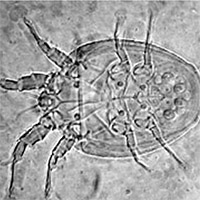Mites and how to avoid them
Mites - what they look like
 The biggest threat to Drosophila culture is mite infestation. While some mite species only share the flies' food, others eat fly embryos and pupae and can eventually wipe out a fly lab. Even ‘food mites' can increase in number so rapidly (often by parthenogenesis) that they can destroy fly stocks. Adult mites are smaller than a Drosophila embryo, so can be difficult to detect. In older Drosophila cultures, they will normally be found wandering around the empty pupal cases. Mite embryos are even tinier and are often found in pearly strands of 10-20 eggs between Drosophila pupae.
The biggest threat to Drosophila culture is mite infestation. While some mite species only share the flies' food, others eat fly embryos and pupae and can eventually wipe out a fly lab. Even ‘food mites' can increase in number so rapidly (often by parthenogenesis) that they can destroy fly stocks. Adult mites are smaller than a Drosophila embryo, so can be difficult to detect. In older Drosophila cultures, they will normally be found wandering around the empty pupal cases. Mite embryos are even tinier and are often found in pearly strands of 10-20 eggs between Drosophila pupae.
In the video below (between 0.45 and 1.50),a single adult mite is seen walking through a Drosophila culture before pausing at a pupal case. You can see how small the mite is compared to the passing flies and the pupa itself.
Mites - how to control them
Mites are everywhere, so constant vigilance is required to keep Drosophila cultures 'mite free'. These three precautions are the most effective for controlling mites:
- Quarantine all incoming Drosophila stocks. Any new stocks that enter the lab need to be kept isolated from the main stocks for at least 2 full generations (see full quarantine procedure below).
- Transfer fly stocks regularly. The life cycles of most mite species that infect Drosophila cultures are a little longer than that of the fly. If the flies are transferred soon after they eclose, the mites will not have completed their life cycle and so should not be able to overwhelm the stock.
- Keep the fly lab spotlessly clean. Mite species thrive on the detritus that accumulates in fly incubators and around working areas in the fly lab. It is important to clean/wash all equipment that comes into contact with flies and fly cultures. Mites and their eggs can be killed by ethanol, so wiping down your microscope, bench, CO2 pad and brushes with ethanol before and/or after you handle your flies is recommended.
Help! I've got mites.
It is not a sin to find mites in your fly stocks, but it is a sin to do nothing about it. If you discover mites in one of your stocks you should:
- Immediately remove the infected vial from the lab, seal it in an autoclave bag and arrange for it to be autoclaved as soon as possible. Closely monitor all fly vials that were kept close to the infected vial, and discard any that also become infected.
- Wipe down everything that has come into contact with the infected vial with ethanol. This includes the container the flies were kept in, the area where you worked with the flies and any tools you used to work with the flies.
- Inform the Fly Facility staff, we need to know.
- Select ~5 pairs of flies that don't appear to be carrying mites or mite eggs and place them in a clean vial.
- Transfer the flies to new food 3 times, once every 2 days, and keep only the last vial.
- Monitor the rescued stock for at least 2 full generations (follow the quarantine procedures described below) to ensure that it is mite-free.
How to quarantine new Drosophila stocks
To guard against mites, all flies coming into the lab from other labs or stock centres must go directly to the Isolation/Quarantine area and remain there for at least 2 full generations. Our recommended quarantine procedure is:
- Write the arrival date on the fly vial you have just received. Transfer any adults, or the first flies that eclose, into a fresh vial. These are your G0 flies.
- Keep the original vial for at least 3 weeks. Periodically inspect it, under a dissecting microscope, to check for the presence of adult mites and/or mite eggs especially around the pupal cases.
- When it is clear that your new culture is growing well, discard the G0 adults and allow the F1 adults to develop. Inspect the vial regularly for the presence of mites or other problems e.g. fungal or bacterial growth.
- Transfers some F1 adults to a new vial. When this culture is growing well, discard the F1 adults and allow the F2 generation to develop. Regularly inspect the tube for mites etc.
- If no mites were seen in the original vial or any of the subsequent vials then some F2 flies can be transferred into a new vial and brought into the main lab.
- If mites are detected at any time you can attempt to rescue the stock by selecting a small number of mite-free flies and performing rapid transfers (as described above). You must then repeat the full quarantine procedure.
IMPORTANT: If you are unsure what mites look like or would like confirmation that your cultures are mite-free, please ask a member of the Fly Facility staff or some other experienced fly worker.
Adapted from John Roote (2008) by Simon Collier (2014)
